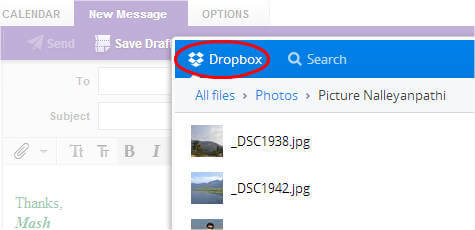
- #FORWARD MY PICTURE TO GOOGLE DROPBOX HOW TO#
- #FORWARD MY PICTURE TO GOOGLE DROPBOX PRO#
- #FORWARD MY PICTURE TO GOOGLE DROPBOX PROFESSIONAL#
- #FORWARD MY PICTURE TO GOOGLE DROPBOX FREE#
#FORWARD MY PICTURE TO GOOGLE DROPBOX FREE#
In terms of document storage, the first 15 GB is free, which, again, should be plenty for many casual users.Īnother wrinkle is that some may have concerns about the true cost of Google’s free services, including its privacy practices. Google Photos won’t cap quality if users subscribe to a Google storage plan, which ramps up in price depending on storage needs, starting at $1.99 per month for 100 GB of storage.
#FORWARD MY PICTURE TO GOOGLE DROPBOX PROFESSIONAL#
Though that should be perfectly acceptable to many casual users, it won’t be suitable for, say, professional photographers or hardcore enthusiasts. And, needless to say, local backup and network drives are also an option.Īnd it’s important to note that the free option of Google Photos, while offering unlimited storage overall, caps individual photo uploads to 16 MB and videos to 1080p. Many other cloud storage options are also available: Tech Radar recently compiled a good comparison. Amazon Cloud Drive and Amazon Photos are also worth a look especially to Amazon Prime subscribers who get Amazon Photos’ unlimited photo storage as part of the Prime package. Those who have gone all-in with Apple’s ecosystem of products should definitely explore iCloud, which remains a much cheaper alternative to Dropbox. Let’s look at some of those caveats up front before making the switch out of Dropbox.ĭo note that Dropbox and Google are by no means the only game in town when it comes to cloud storage. We’ll also flag all the considerations you’ll need to be aware of along the way.
#FORWARD MY PICTURE TO GOOGLE DROPBOX HOW TO#
For the purposes of this guide, we’ll show you how to switch to an option that, at the moment, is totally free to use – though with caveats: Google Drive and Google Photos. If you’re using Dropbox to backup photos and important documents, there may be better value for money alternatives. For many home users, 2 TB is way more than is needed. While undoubtedly an excellent service, Dropbox is increasingly pitching itself as a business product.

Though the price remains $9.99 per month with annual billing, $120 is a lot to pay.
#FORWARD MY PICTURE TO GOOGLE DROPBOX PRO#
The company says File Requests is currently available for Dropbox Basic and Pro users, and will arrive for Business customers in the next few weeks.This year, Dropbox doubled the available storage available to Plus subscribers from 1 TB to 2 TB, but with it came a US$2 hike to the monthly subscription, up to $11.99 per month. Of course, the feature also lets you ask for files from those who are already on Dropbox – in that case, it just simplifies the collection process by centralizing all the uploads into a single folder available across your devices. In addition to making it easier for current Dropbox users to ask for files from others, the new option may also serve to introduce Dropbox to others who had yet to try the service. Then they can either copy the link Dropbox provides (which points to a file uploader interface), or they can enter in the email addresses and message they want to send. When asking for files, users can also indicate which folder should host the files as part of the request process. Dropbox says that, unlike with email attachments, people can send files as large as 2 GB in size using File Requests. The feature has another advantage, as well – it works with larger files, like video. They were asking for really complex PowerPoint decks.” The previews team used file requests, asked people around the company for documents that are hard to render in order to challenge their rendering pipeline. “One of the most interesting examples internally was when we were working on document previews. “We’ve had it internally built and in testing for quite a while,” Dropbox product head ChenLi Wang said. The company suggests the feature can be used for a range of sharing scenarios, whether it’s collecting bids from contractors, asking for files from clients, or even asking family members to share vacation photos. This continues to be the case because not everyone uses the same cloud service for file sharing, too.ĭropbox’s File Requests feature is meant to offer an alternative to email-based file sharing, as it puts those in need of the files in more control. Today, most people continue to share files with one another as email attachments, which can be cumbersome to sort through. The company says the feature was implemented to address a common pain point among users.

Through a simple interface on /requests, you can specify what file or files you’re looking for, and you’re then provided a link you can distribute or you can select the option to have Dropbox send a request email on your behalf. Called “File Requests,” the option gives anyone you ask the ability to upload files into your Dropbox account, into a folder of your choosing. Dropbox today rolled out a new feature that will allow those without an account to share files with Dropbox users.


 0 kommentar(er)
0 kommentar(er)
